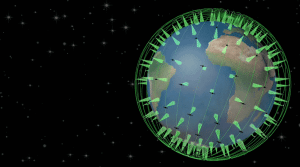Latest News

How a proposed constellation of satellites with thermal infrared imaging sensors would locate wildfires. Photo: Quadra Pi R2E
[Via Satellite 11-24-2015] NASA’s Jet Propulsion Laboratory (JPL) in Pasadena, Calif., is working on a concept for a network of space-based sensors called FireSat in collaboration with Quadra Pi R2E, form San Francisco, Calif. FireSat would be a constellation of more than 200 thermal infrared imaging sensors on satellites designed to quickly locate wildfires around the globe. Once operational, FireSat would represent the most complete monitoring coverage of wildfires ever from space, according to NASA.
“While many wildfires are reported by 911 calls soon after ignition, some are not, and delays in detection can lead to rapid escalation of a fire, and dramatic growth of the cost of suppression. The system we envision will work day and night for fires anywhere in the world,” said Robert Staehle, lead designer of FireSat at JPL.
The FireSat sensors would be able to detect fires that are at least 35 to 50 feet (10 to 15 meters) wide, within an average of 15 minutes from the time they begin. Within three minutes of detecting a fire from orbit, FireSat would notify emergency responders in the area of the fire, improving support for time-critical response decisions. The sensors and their associated products for data analysis would also be able to locate explosions, oil spills and other dangerous events involving high heat around the globe, NASA says.
FireSat sensors would complement the fire monitoring done by NASA satellites and systems already in place. While existing satellite-based fire-searching sensors can only detect fires about twice a day, and transmit large images, FireSat would be able to send a low-resolution image of a fire once per minute, along with the latitude and longitude of exactly what is burning. This would enable faster, nearly continuous communication with the ground.
JPL will assist in the design, demonstration and development of the proposed sensor constellation. Ecliptic Enterprises Corp. from Pasadena, Calif., will serve as the production supplier for the sensor assemblies.
The current plan is to have a fully operational system of FireSat sensors in space by June of 2018.
Get the latest Via Satellite news!
Subscribe Now